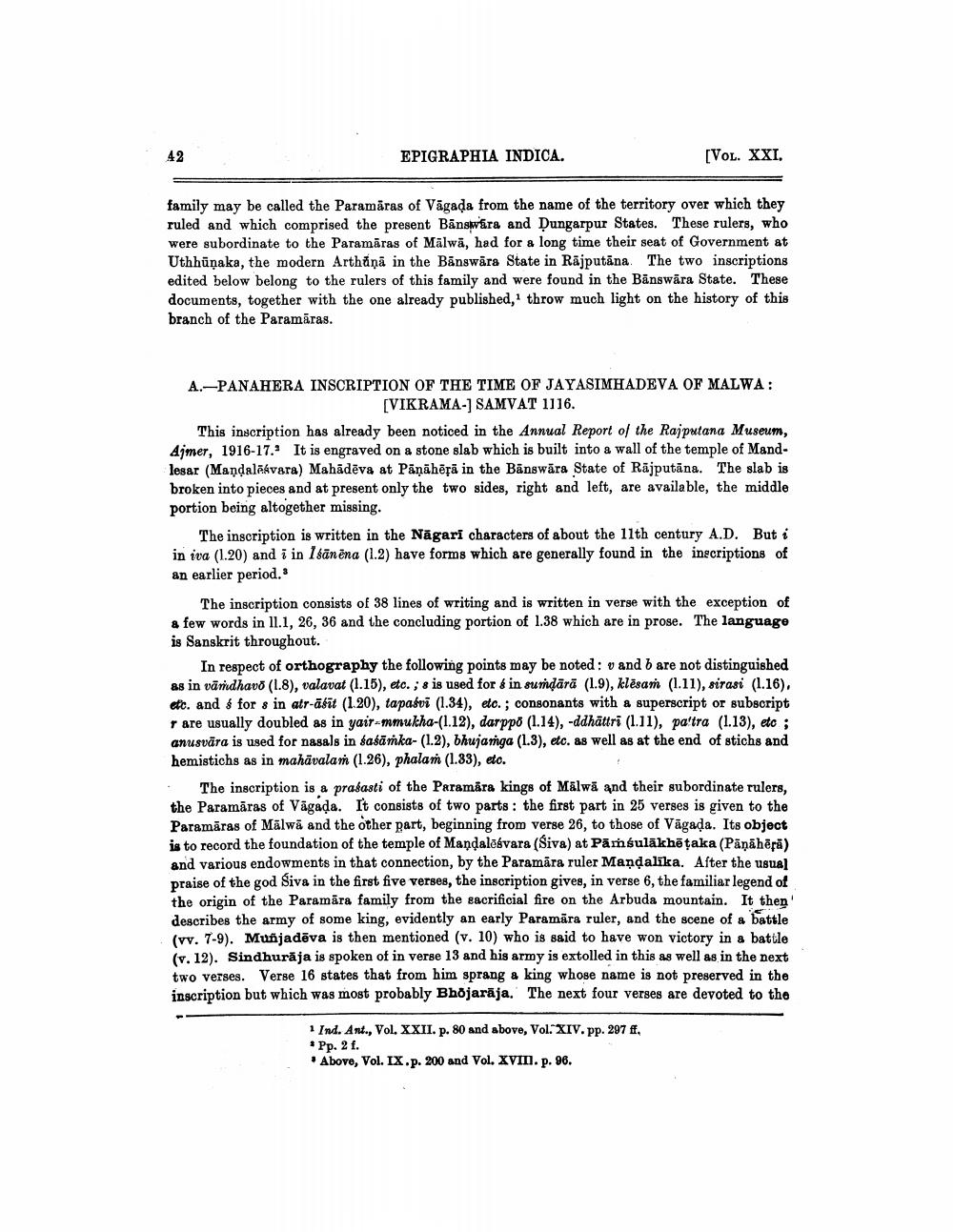________________
42
EPIGRAPHIA INDICA.
[VOL. XXI.
family may be called the Paramāras of Vāgada from the name of the territory over which they ruled and which comprised the present Banswara and Dungarpur States. These rulers, who were subordinate to the Paramāras of Malwa, had for a long time their seat of Government at Uthhūņaka, the modern Arthăņā in the Bāngwära State in Rājputāna The two inscriptions edited below belong to the rulers of this family and were found in the Banswara State. These documents, together with the one already published, throw much light on the history of this branch of the Paramāras.
A.-PANAHERA INSCRIPTION OF THE TIME OF JAYASIMHADEVA OF MALWA:
[VIKRAMA-) SAMVAT 1116. This inscription has already been noticed in the Annual Report of the Rajputana Museum, Ajmer, 1916-17. It is engraved on & stone slab which is built into a wall of the temple of Mandlesar (Mandalakvara) Mahadeva at Paņāhēļā in the Banswara State of Rajputana. The slab is broken into pieces and at present only the two sides, right and left, are available, the middle portion being altogether missing.
The inscription is written in the Nāgari characters of about the 11th century A.D. But i in iva (1.20) and i in 1 sānēna (1.2) have forms which are generally found in the inscriptions of an earlier period.
The inscription consists of 38 lines of writing and is written in verse with the exception of & few words in 11.1, 26, 36 and the concluding portion of 1.38 which are in prose. The language is Sanskrit throughout.
In respect of orthography the following points may be noted: v and b are not distinguished as in vārdhavd (1.8), valavat (1.15), etc. ; 8 is used for & in surdārā (1.9), klēsan (1.11), sirasi (1.16). etc. and $ for sin atr-ātīt (1.20), tapasvi (1.34), etc.; consonants with a superscript or subscript
are usually doubled as in yair-mumukha-(1.12), darppo (1.14), -ddhättri (1.11), pa'tra (1.13), etc; anusvāra is used for nasals in fasāṁka- (1.2), bhujanga (1.3), etc. as well as at the end of stichs and hemistichs as in mahävalan (1.26), phalan (1.33), etc.
The inscription is a prasasti of the Paramåra kings of Malwa and their subordinate rulers, the Paramāras of Vagada. It consists of two parts: the first part in 25 verses is given to the Paramāras of Mālwā and the other part, beginning from verse 26, to those of Vägada. Its object is to record the foundation of the temple of Mandalasvara (Siva) at Pāmśulākhēțaka (Pāņāhēra) and various endowments in that connection, by the Paramāra ruler Mandalika. After the usual praise of the god Siva in the first five verses, the inscription gives, in verse 6, the familiar legend of the origin of the Paramāra family from the sacrificial fire on the Arbuda mountain. It then describes the army of some king, evidently an early Paramāra ruler, and the scene of a battle (vv. 7-9). Munjadēva is then mentioned (v. 10) who is said to have won victory in a battle (v. 12). Sindhurāja is spoken of in verse 13 and his army is extolled in this as well as in the next two verses. Verse 16 states that from him sprang a king whose name is not preserved in the inscription but which was most probably Bhojarāja. The next four verses are devoted to the
1 Ind. Ant., Vol. XXII. p. 80 and above, Vol. XIV. pp. 297 4. . Pp. 2 f. . Abovo, Vol. IX.p. 200 and Vol. XVII. p. 96.




